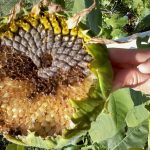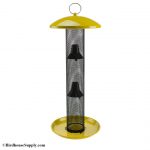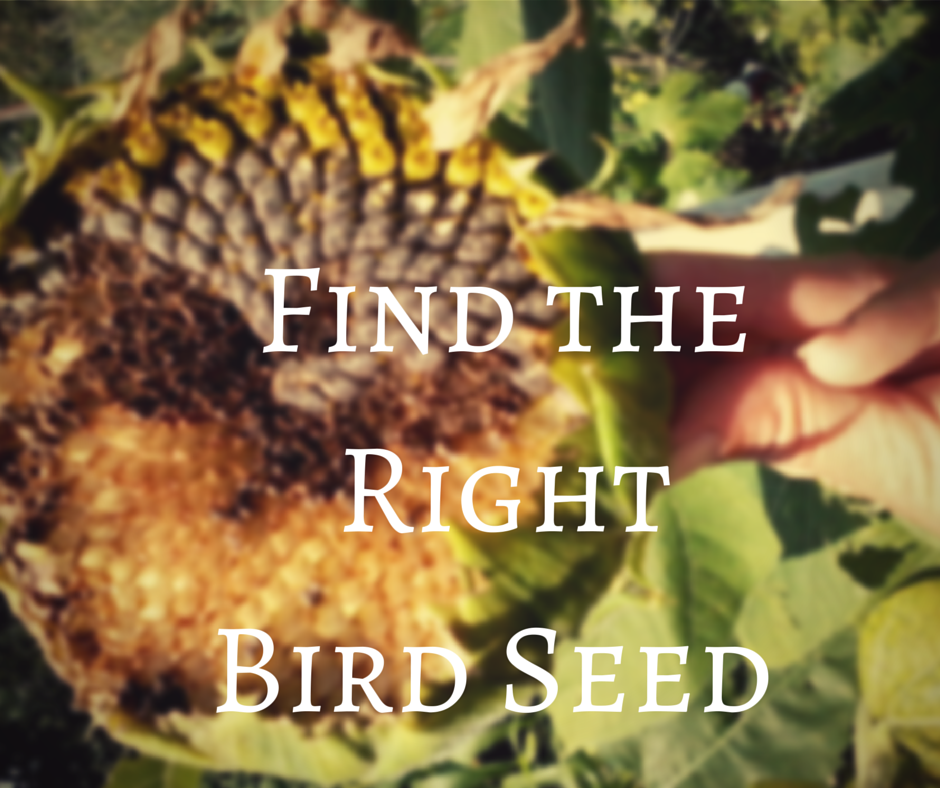You walk into the big warehouse store with your shopping list.
Your bins of wild bird seed are getting low and it’s time to restock to keep your avian (and squirrel) diner in top operating condition.
You want to be sure you are choosing the best seed and mixes for your customers.
What do you do?
What if you have been buying the wrong seed, or worse, the “lousy” brands?
The customer satisfaction sheets you left on the tree by the tube feeder have not been touched. Is that a bad sign?
“Bad Seed”
This label refers to more than wayward descendants. Buying bad seed is a real health risk for your birds. At the least – your dollars get wasted and you need to clean up the tossed “junk” scattered on the ground – that translates to money AND time in the compost bin.
Birds will let you know what is NOT the chef’s best selection.
Poor quality seed has an even bigger impact on your feeding stations. It can have a cumulative effect on the birds if it is old, stale, or if the seed has not been stored properly by the seller or manufacturer. “Bad” seed can harbor disease organisms such as mold or bacteria and it can have a lowered nutritional value.
Seed that gets tossed quickly begins to spoil as it sits on the ground. Cleaning this seed up is paramount. You may even have to clean and disinfect the feeders, as these poor quality grains are often full of sticks, dust and other non-edibles that enhance spoilage and clog bird feeders.
How to recognize bad seed:
“Cheap” seed is easily recognizable.
- Watch for mixes that contain wormy or powdery looking sunflower seeds (usually the striped variety). Crack open a few of the sunflower seeds. You may find black spots/holes or shrunken seed meats. If the seed doesn’t look appetizing or plump and fresh – it isn’t.
- Cracked corn will be the main ingredient. This is not a good grain choice and corn spoils very quickly. It can also harbor dangerous mycotoxins if not handled properly. Other filler seeds to watch for – red millet, safflower and flour grains such as wheat or oats.
- Look for stones, dirt, sticks, weed seeds, burrs, and you-name-it in the bag. Birdseed is a field grown product (and it is not screened for human consumption), but if you are noticing an unusual amount of “extras” in your bag this will signify that the seed has not been carefully harvested, sourced or stored.
Warning: Never feed any seed products that are exhibiting must or mold (powder, dark films, fine dust), rodent droppings, have been wet or are wet, contain bugs or wispy cottony growths. Even though birds love to munch insects – insects in their grain is a very bad sign.
Dispose of tainted feeds in the compost bin (where birds cannot access them), or in the trash. If you have bought seed with these elements return the purchase to the store. Bugs in the bag occasionally occur due to weather and other events. The store will want to know.
Sunflower Seed
 Few birds that visit feeding stations will turn their beaks up at sunflower seed. Sunflower seed is packed with rich energy-giving oils and fats. The squirrels know this too.
Few birds that visit feeding stations will turn their beaks up at sunflower seed. Sunflower seed is packed with rich energy-giving oils and fats. The squirrels know this too.
Sunflower seeds come au naturel or still in the flower head. This decorative dispenser looks great and is very easy to hang. Birds in the finch and chickadee group love to feed straight from the dried flower. If you have some land, or are a gardener, sunflower seed = free bird food.
Stokes has an interesting series on gardening for birds. Most people choose the black oil seed. But sunflowers are available in dozens of varieties and in all sizes and colors. These are beautiful in the backyard and the birds will partake from all of them.
If you are buying sunflower seed the varieties dwindle to two – striped and black oil.
Striped seeds are larger than the black oil and the shells can clog some feeders. Smaller birds dislike the unwieldy size of these. The larger shells are easier to clean up, but the striped are not a popular purchase.
In some regions the striped variety is hard to find. The stores will be carrying only the black oil. Black oil sunflower seeds should be plump and firm and the nutmeats oily and luscious. The easy-to-crack shell is perfect for your siskins and finches. Blue jays will pop them down whole.
All sunflower seeds leave a “delightful” trash heap of shells under your feeding station. It can get mucky and moldy fast. Even if you leave a clearly marked “shelling” bucket for the birds and squirrels to put their shells in – they rarely do – leaving you with the mess. This scattering of husks will be found wherever the birds crack their seeds. Birds tend to “crack” under predictable spots in bushes and branches leaving piles of sunflower shells all over your (and your neighbor’s) yard.
Purchasing shelled sunflower is an option. It is quite expensive and may not be cost effective for heavily visited stations. Cornell University also warns that:
“Without the protection of the shell, sunflower hearts and chips quickly spoil, and can harbor dangerous bacteria, so it’s important to offer no more than can be eaten in a day or two.”
Soup to Nuts
Buying seed mixes is the best solution for keeping most avian customers content.
Seed mixes contain white (proso) millet – a favorite of the spectacular buntings – safflower, thistle and small pieces of cracked corn and peanuts. Many birds enjoy nutmeats. A few species that do are the cardinals, blue jays, nuthatches, woodpeckers, finches and grosbeaks.
Some blends also offer dried fruits. Catbirds, mockingbirds, waxwings and robins enjoy fruit selections.
Packages will designate what species of wildlife the feed is made to attract.
You can always prepare feeds from scratch. Watch what your visitors are eating and mix the seed, fruit, nut and dried mealworms that get the best reviews.
To read a short article on seeds and species visit Stokes.
A Note on Nyjer
 Nyjer, or thistle, is usually included in many mixes. It can be fed separately and many birders have a separate thistle station.
Nyjer, or thistle, is usually included in many mixes. It can be fed separately and many birders have a separate thistle station.
If not mixed in with other seeds or sunflower meats, the thistle will fall out from regular tube feeders. If you choose to feed thistle purchase a feeder labeled for this seed. You will notice that the seed ports are slits instead of round holes.
Bird House Supply has a variety of nyjer feeders and accessories for bird feeding.
Regions
Observe what species of birds fly into your region. Read local bird watching articles. Often, these lists are posted in your newspaper. Many clubs list sighting reports to keep everyone “up-to-date” on what species are visiting the area.
Regions dictate seed choice.
“Western birds tend to consume milo more than eastern birds. In the east, it is best to avoid mixes with large amounts of milo,” according to Feeder Watch.
Your customers are your best source of menu information. Just because the experts say doves love cracked corn, doesn’t mean that YOUR doves will! Many a goldfinch has shrugged at the thistle and headed over for the black oil sunflower.
Feed what keeps them happy.
Try new foods.
Don’t worry, these feathered diners won’t be shy. And…you never know which one is the designated mystery diner – so keep up on the quality!


